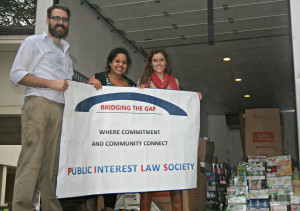You Need a Montage: the Resume Makeover Scene
Sam Halpert, 2014 – 2015 PSJD Fellow
So yesterday I confessed to you all that in my own job search, I’m far from I’m figuratively far from a master. However I work a mere foot away from one. Christina Jackson, NALP’s Director of Public Service Initiatives and Fellowships, will be putting me through my paces for your benefit from now until next semester so you can see how PSJD’s 10-Step Program for keeping your job search warm over the holidays works in practice.
Since then, I’ve been hard at work on Tip 1 (reviewing my resume and cover letter). I shared the most recent version of my resume with Christina, along with a couple of job posts that came up on PJSD that caught my eye (a Pro Bono Coordinator and a Housing Advocate, PDF’d here for posterity).
Christina had solid advice for restructuring and refining my resume. I’ve summarized her strategy below, illustrating it with examples from my two new resumes (you can see all the changes I made in the full versions — “Coordinator” and “Advocate“):
- YOUR GOAL: Speak the employer’s language. Your resume and cover letter are a one-two combination aimed to land you an interview. Between them, you need to fit as many of the position’s advertised responsibilities, duties, and qualifications as you can. Reorganize, rephrase, and rewrite your experiences so the employer sees you describe yourself in the terms they would use.
This means each resume will be different, depending on what kind of employer you’re speaking to. Make categories based on the method of work you’d like to employ, the clients you’re seeking to serve, and the area of law you’d like to apply. Within these categories employers are likely to use similar language and have similar expectations. Write resumes for each one, and you won’t have to do a custom job for each application you send off.Pro Bono Coordinator Example
Housing Advocate Example
Responsibilities: “Coordinate and support the development of…the probono.net platform.” Responsibilities: “Engaging community coalitions, advocates, and public officials.” New Resume: “Coordinating with PSJD Advisory Group to develop new resources & features…” New Resume: “[Executed human rights fact-finding mission] by engaging community groups to convince individuals to participate.” - WHAT TO CUT: Look for sections that don’t say something meaningful or new. For example, research has been a component of several of my jobs so Christina downgraded my Research Assistant position to an “activity.” When she didn’t see how my summer program spoke to the “Coordinator” position, she cut it entirely. (I added it back for the “Advocate” resume; my activities that summer demonstrate experience with community advocacy.)
- WHAT TO INCLUDE: Be specific — or as specific as you can. Provide concrete examples of the kinds of work you’ve done in your various experiences. For one position on my old resume, I’d “co-authored pre-mission documents” and “conducted interviews.” Christina wanted to know more: What kind of information did the documents include? How many interviews did your team conduct?
This gets tricky when your work is confidential: Focus on processes, not issues, and remember you may need help. If you’re a student or a recent grad struggling to describe your experience without giving anything away, consider showing your proposed language to your supervisor. They can help you find words that will let employers picture your work without learning confidential details of your clients’ affairs. - WHAT TO EXPECT: Be prepared to be uncomfortable. You’re editing your life for someone else. According to Christina, as a law graduate it’s time for me to retire my GPA from my resume. With the exception of positions that specifically mention “strong academic credentials” or request a transcript, in most graduates’ applications a GPA just takes up space. This was difficult for me to accept. I worked hard for that number. Apparently, though, it means a lot to me but not to most employers. And without it I have more space to say other things and present a package with fewer extraneous details distracting employers from my message. So I took a deep breath, and held down backspace.
- TWO NOTES ON LARGE-SCALE ORGANIZATION:
- For students and recent grads, “education” comes first. But generally, two years after graduation “experience” officially trumps. If you’re closer to your fifth reunion than your 1L year, consider moving your “education” section below “experience” unless you’re applying to a job where your education ties you to the institution you’d work for or the location you’d move to.
- “Experience” typically matters more than “publications” — unless you’re going for a particularly writing-intensive job (e.g., judicial clerk) or your publications speak to your relationship with a particular client group, method of work, or area of law. For example, I moved my “publications” section forward on my “Advocate” resume because one of the reports I co-authored specifically involved housing issues.
I have more work to do on both of these documents. These versions have gone a little overboard, which can happen when you find a position where a lot of your experience is on point. I need to cut each one back a bit, but hopefully these five tips and examples are enough to get you started on your own resume makeovers this weekend. I’ll be chugging along ahead, working on matching cover letters to share with Christina (and you) next week.
Wax on, wax off.
-Sam
Permalink Comments off






